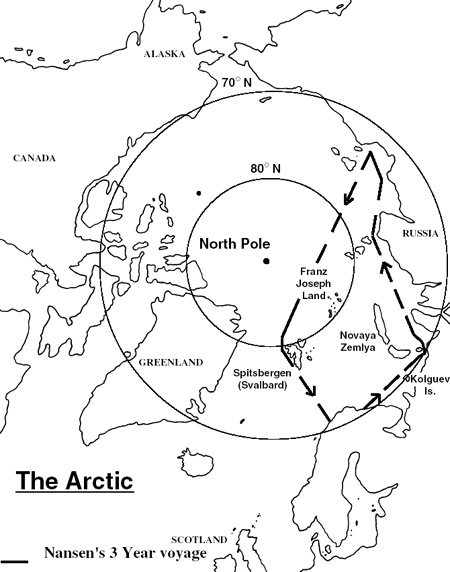
| Glasgow Digital Library | Voyage of the Scotia | BRUCE | PEOPLE | SHIP | ANTARCTIC | INDEX |
|---|

Nansen's first voyage to the Arctic was in 1881. In 1888 he led the first crossing of Greenland which was virtually unknown territory at that time.
Nansen was convinced there was a marine current from Siberia across the North Pole to Greenland and in 1883 he set off on the specially strengthened ship Fram. The ship was so constructed than when trapped by the ice it would be squeezed upwards. She carried supplies for five years.
Nansen sailed east to the Laptev Sea before entering the ice. The ship was carried north and after 18 months reached 83°59'N, 360km (230 miles) from the North Pole, a new record. Nansen left the ship with dogs and sledges to journey to the North Pole with his companion Johansen. They reached 86°14'N before turning back due to the cold and a dwindling food supply. They decided to make for Franz Joseph Land 665km (415 miles) away.
Nansen and Johansen set off across the ice with sledges, kayak and the three remaining dogs. They were within 240km (150 miles) of their destination when the weather set in for the winter and they were forced to dig a snow hole in which they stayed for nine months, living on seals, walruses and polar bears. Seal oil was used for cooking and heat.
The two explorers eventually reached Franz Joseph Land to await transport home. The relief ship Windward was carrying supplies for the Jackson-Harmsworth expedition. Bruce was aboard Windward. He and Nansen became good friends and met on several occasions in future years.
Fram broke out of the ice and returned to Norway about the same time as Nansen. Fram was used for the Norwegian Antarctic Expedition in 1910-11 when Roald Amundsen reached the South Pole. The vessel is now in the Oslo Museum.
Nansen went on to chair the zoology department at Oslo University and later became Professor of Oceanography. He gained the Nobel Peace Prize in 1922 for his work for refugees after the first world war. In 1926 he was elected rector by the students of St Andrews University.
| Glasgow Digital Library | Voyage of the Scotia | BRUCE | PEOPLE | SHIP | ANTARCTIC | INDEX |
|---|